10 Common Classroom Procedures to Teach for a Great School Year
The bell rings after summer break and it’s time to teach common classroom procedures! Not only do we teach these at the beginning of the year, but we must also teach these throughout the year- after breaks or when students start “forgetting” what the common classroom procedures are. And remember, when these 10 common classroom procedures and expectations are in place and followed, teaching and learning can really happen!
In This Post
We will go over 10 common classroom procedures to teach at the beginning of the year and throughout the school year. Of course there are plenty more, but these are common classroom procedures that we encounter each day. I’ll also talk about how to teach these procedures and how to reinforce, correct, or adjust them. I’ll share some classroom procedure ideas of what it might look like in your classroom.
Be sure to grab your free guide 7 Daily Must-Do Routines to Run Your Science Classroom Like a Pro.
Disclosure: This post contains some affiliate links for your convenience. As an Amazon Associate I earn from qualifying purchases with no cost to you. You can get many books on Audible to listen to while you are driving, working out, or relaxing. Click this link for a free trial and get a free audiobook!
What are some classroom procedures?
There are many procedures that we must teach. I will focus on the top 10 common classroom procedures to start with at the beginning of the school year. With these procedures in place, your school year will run smoothly.
Here is a list of classroom procedures:
- Entering the room
- Getting students’ attention
- Getting materials
- Using the restroom
- Food and drinks
- Listening when someone is speaking
- Interacting in a group
- Turning in work or papers
- Packing up and cleaning
- Dismissal
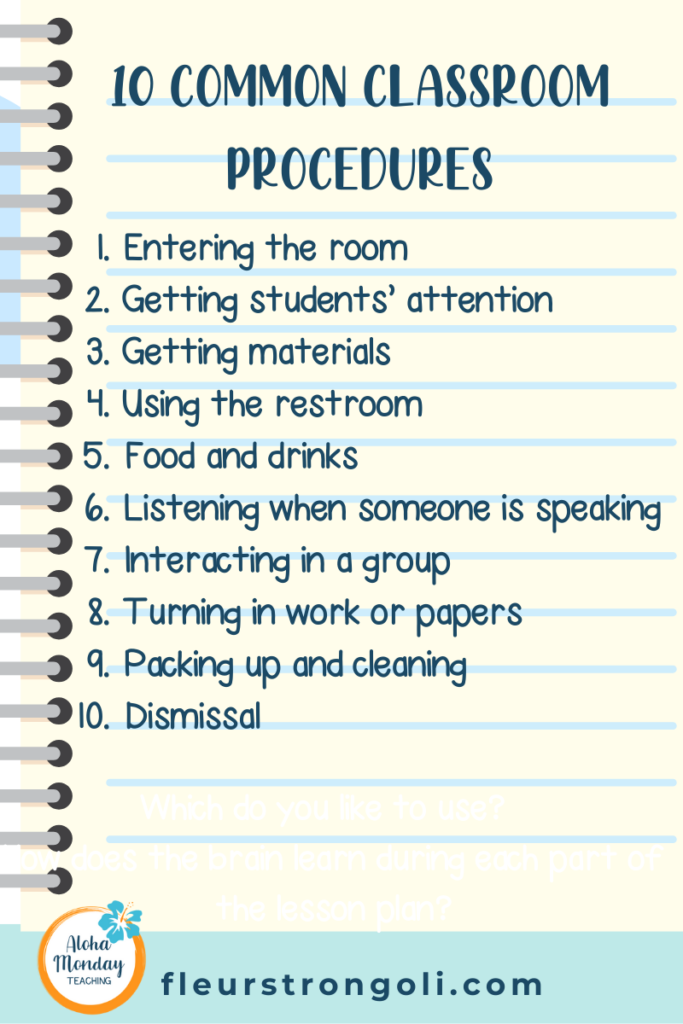
How to Teach Classroom Procedures
When you are teaching a procedure, ensure that you have the students’ attention. Be very clear with your expectations and how the procedure works. You will need to give opportunities for the students to practice the procedure. You must also reinforce and correct immediately.
Here is an example for teaching the procedure for gaining students’ attention.
Teach the signal(s) you will use to gain your students’ attention when they are working or in a discussion. In my classroom, we use a doorbell and a call and respond. An example of a call and respond from the book Whole Brain Teaching for Challenging Kids (and the rest of the class, too!) is to say “Class Class,” and students respond with “Yes Yes”.
Ask students what they should do when they hear the sound. Students should stop what they are doing, look at you, and be quiet to show that you have their attention.
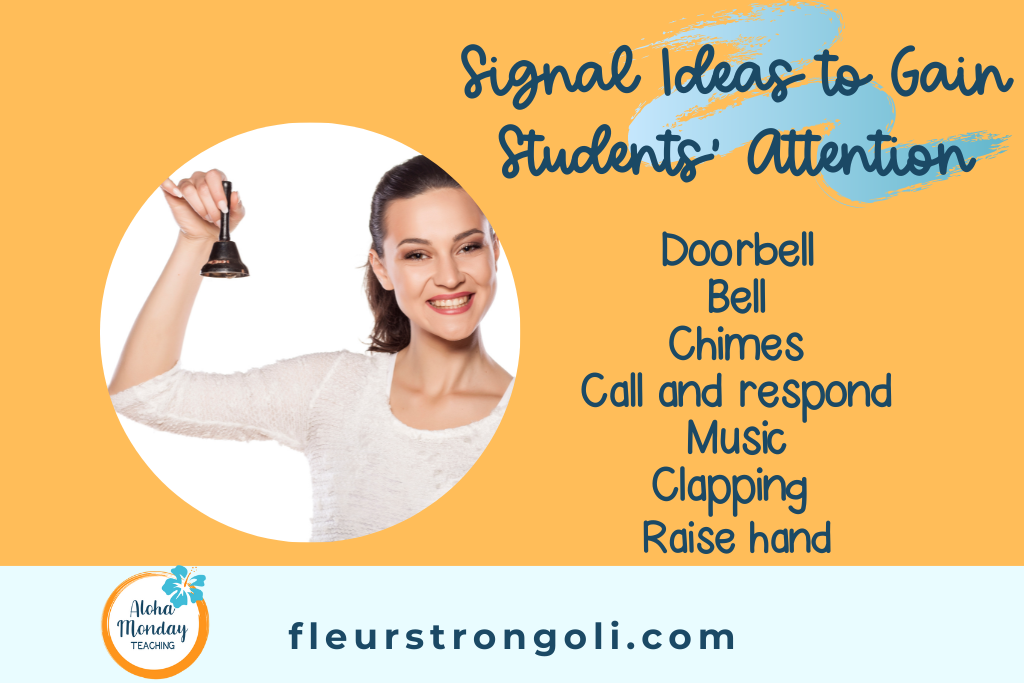
Practice it with students. Give them a task, like a mingle activity around the room. Signal your students and wait for them to stop what they are doing, look at you, and be silent. Resist the urge to signal again. You want students to do what is expected and train them to do this quickly.
When you have the students’ attention, praise and reinforce them by telling the students what they did correctly. “Great job looking at me when you heard the signal.” “You helped others quiet down and look at me when I needed their attention.” “I noticed you stopped what you were doing quickly when you heard the signal.”
Correct students in a calm and firm manner when they do not do the procedure quickly or correctly. Remind them what they need to do when they hear the signal. For example, I say something like, ‘Remember, when you hear the signal it means I need your attention. You stop what you’re doing, look at me, and you are quiet. If someone is still talking, please give them a gentle reminder or let them know that I need their attention.” You can say, “I signaled, and half the class was ready but the other half must not have heard the signal. What do we do to help everyone when I need your attention?”
Continue practicing this over the class period and several days with reinforcement and corrections. This will ensure that students follow your procedure to give you their attention. Be consistent and if you need to make adjustments to a procedure, tell the students. Then you will need to teach it, practice, reinforce, and correct.
This is the basic strategy for teaching your procedures. Teach, practice, reinforce, and correct.

Classroom Procedure Ideas
Let’s take a look at what the other nine common classroom procedures might look like for you. Go through the same process to teach the procedure as we talked about with gaining students’ attention.
Entering the Room
When students enter the room, they should know exactly what to do. Students should enter the room quietly, walk, and go to their seats. They should know what to do with their backpacks and water bottles. Post their instructions on the screen or white board. This is what I created and use in my classroom each day. There should be a task for them to complete- be prepared with materials or answer a warm up question.
Think about: Where do they turn in homework or papers? What task will you have them do? What do you do if they don’t follow directions?
Getting Materials
During class, students may need to get materials from different parts of the room. This includes sharpening pencils, getting papers, obtaining lab materials, getting a laptop, or borrowing crayons and colored pencils.
It is important to have materials ready when students need them. It’s also a good idea, if possible, to have student materials in a designated area. In my classroom, my pencil sharpener is near the laptops and paper drawers. All of my coloring utensils are in a lab table. I have glue sticks and scissors in another lab table. When we are doing a lab, all of the materials are in a designated area.
Teach students where materials are, what they are allowed to use, and when they can gather materials. They should also be told the expectation of taking care of materials when they are using them. And if you have laptops in your classroom, be sure they know how you expect them to get their laptop, use it, and put it away.
Think about: Should they raise their hand during instruction to sharpen a pencil or just get up to sharpen it? What should students do if they need a material that is put away? How will students return materials and clean up? Do students have assigned laptops?
Using the restroom
With our limited time to teach each class period, we hope that students will go to the restroom during their passing time. But, as you know, students still need to go during class. Students should know when it is acceptable to use the restroom during class. They should know how to ask you for permission and if they need a pass or have to sign out on a sheet. I tell students when they use the restroom, they take care of business, wash their hands, and come right back to class.
Think about: What are your school’s or grade level team’s bathroom procedures? Is there a limit? Do they have bathroom passes? What if a student has to go as an emergency and has no bathroom passes available? What if a student wanders and just wants to get out of class?
Food and drinks
In a Science lab or classroom, most teachers do not allow food to be eaten. Students can have a water bottle at their desk, but I don’t let them eat in class. I do make an exception for my students with medical needs, and they are aware of it. If you choose to let students eat in class, you must tell them your expectations so you don’t have a mess in class or students munching all period long.
Students should know when it is time to eat. Encourage healthy snacks. Note that some middle schoolers think chips are healthy. They may need a list of acceptable snacks. Teach them to clean up after themselves.
Think about: What if a student is really hungry and you have a no snack rule? What if there are student allergies? What do you do if students do not clean up after themselves?
Listening when someone is speaking
In Science, one of our goals is to communicate with each other. Scientists communicate their ideas and findings with their peers. In class, we aim for this standard too. Students should be quiet and look at the person who is speaking.
When I am teaching students to listen to others, I find myself giving a lot of reminders at the beginning. Before someone speaks, I tell the students the expectation and what it looks like to listen to someone. When they are speaking, I am modeling what it is like to listen. When they are done, if there were students whispering or not listening, I remind them what to do when someone is speaking. Sometimes I will have the student repeat what they said.
I want to point out that when I correct behaviors, I rarely ever say the student’s name. Usually I generalize it, but I do look in the area of the behavior. I do say their name or correct them privately if it is a repeated behavior. When I do these corrections, I am always calm and respectful.
Think about: How do you call on students to speak or share answers? What if a student is not listening? What do you do with a disruptive student? How do you encourage the speaker to talk loudly enough so everyone can hear?
Interacting in a group
When students are working or discussing in a group, they should be listening to each other speak. There are other things to teach when students are interacting. Teach them how to take turns, how to share the responsibility of the task at hand, and how to hold discussions. Kagan’s Cooperative Learning is a great resource to find more strategies.
One way I have students take turns is by starting with one student, and they go around their group clockwise during discussions. I number the seats 1-4 and I will say something like, “Start with Student 2 and go around the group”. I do this with labs and activities too. You can read more about it in this blog post.
Responsibilities students share in a group are working together at the task, taking care of materials, and cleaning up. To make sure each person is doing their part, we must monitor, encourage, and help them participate by showing or telling them what they should do.
And teaching them how to have a discussion is important. Students should be listening when someone is speaking, and feel safe to share their ideas. You can post discussion prompts on the wall to help them. When they are in a small group, I will have one student start the discussion, and they can go around their table clockwise, or just share ideas one at a time.
Think about: What will you do when students are off task? What if a student doesn’t participate at all? What topics will you have them discuss? How often will you have group discussions or activities?
Turning in work or papers
Before students begin working, let them know what to do when they are finished. Perhaps you have a turn in a basket in a designated spot for students to turn in work. Keep it in the same place and be consistent. If students don’t finish an assignment, let them know whether they take it home or if there is a spot in the classroom to leave their work. I have a cabinet for each class to store projects. Otherwise, they take all of their work with them.
When students enter the room at the beginning of class, they turn in papers to the turn-in basket. After their bell work, I will have them turn it into the basket, or they keep it so we can go over it. Sometimes, I will have one group member bring all of their group members’ papers to me. No matter what you choose, students should be told how they turn in work and when to turn in work.
I prefer students to turn in their work to the basket when I am not instructing. They will turn in their work throughout class or at the end of class during clean up time.
Think about: Where is the best place for a turn-in basket? Where do you store those papers for each class? What about papers with no names on them?
Packing up and cleaning
Set aside time at the end of class for students to clean and pack up their things. I give them about 5 minutes, unless we’re doing something that requires a longer time to clean. During those 5 minutes, I put the clean up instructions on a slide so students are reminded what to do. This is also the time to do the exit ticket. When they are done cleaning and packing up, I have them stay near the desks. I check the room to make sure they’ve picked up all of their things and their areas are clean. I like to pick 2-3 exit tickets to read aloud and then give them PBIS points for it.
On a really messy day, I like to play “Magic Piece of Trash”. Yes, they still go for this in middle school. I look around and in my head choose 2-3 things on the floor as the magic pieces. Students pick up anything they find on the floor and show me. Once the room is clean, I announce who picked up the magic pieces of trash and they get a little prize! It’s a win-win!
Think about: How much time do you need to set aside for your students at the end of class? What do they do when they are done cleaning up?
Dismissal
After students have cleaned the room, they should wait somewhere until they are dismissed. Some teachers will have them wait at their desks, while others allow them to begin lining up. I’ve done both. I prefer them to wait by their desks, so the area by the door isn’t crowded. Since my classes are very large, it’s like a mob by the door if I let them line up.
I also teach them that I dismiss them, not the bell. Since they’re already cleaned up, once the bell rings I let them go. The only times I don’t dismiss them right away is if I am correcting behaviors or the room is not clean.
And finally, to end on a fun note, I like to play a song for them at the end of class. I’ll do this either during clean up or while they’re waiting to be dismissed. The songs are usually fun ones that we play during our current unit of study. And on Fridays, I play Aloha Friday!
Think about: Where will students wait until the bell rings? How will you dismiss them?
Wrap Up
We went over 10 common classroom procedures to teach, practice, reinforce, and correct at the beginning of (and throughout) the year. These classroom procedures will set you up for a successful school year. I shared strategies on how to teach the classroom procedures and ideas of what it looks like in a classroom.
Your Turn
Tell me about your classroom procedures. What will you do to help your students have a successful year? What is something new or different that you will try this school year?
And check out the Science Classroom Management Ultimate Bundle!

Read More
How to Establish Science Classroom Expectations for Middle School
2 Simple Steps for an Effective Science Classroom Set Up
What is a Science Lab and How Do I Manage It Effectively?
Products You May Like
Science Classroom Management Ultimate Bundle
Whole Brain Teaching for Challenging Kids (and the rest of your class, too!)
Classroom Routines and Procedures PowerPoint


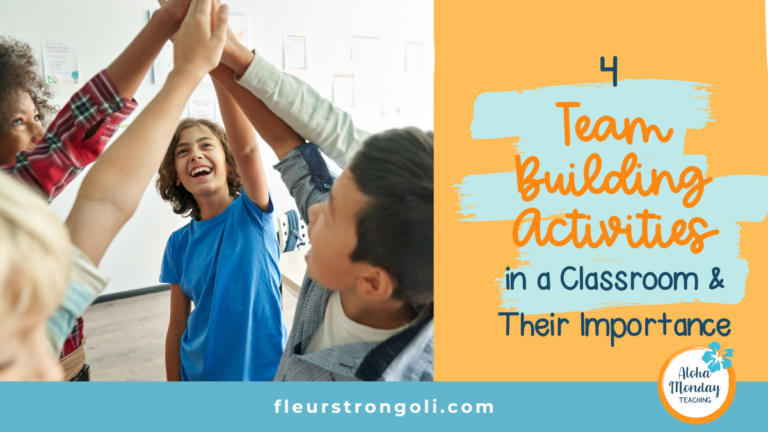
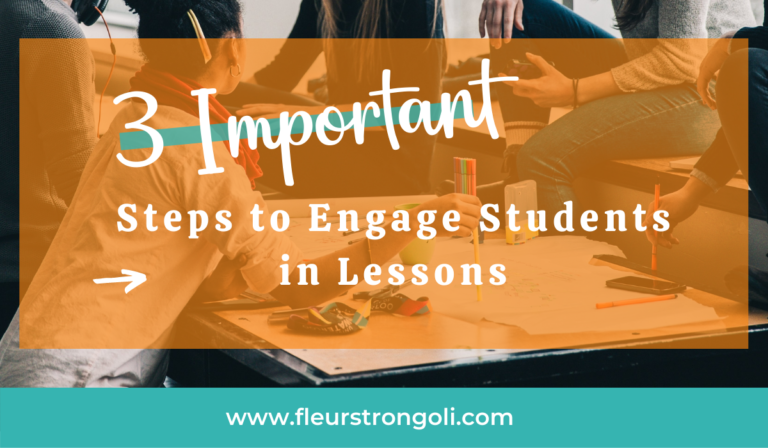
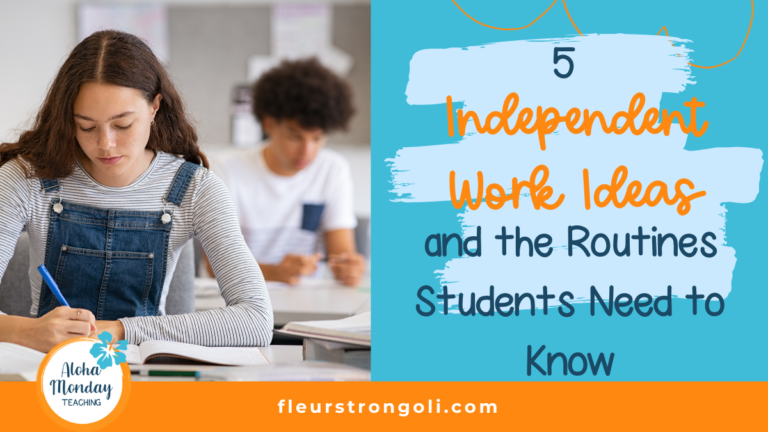
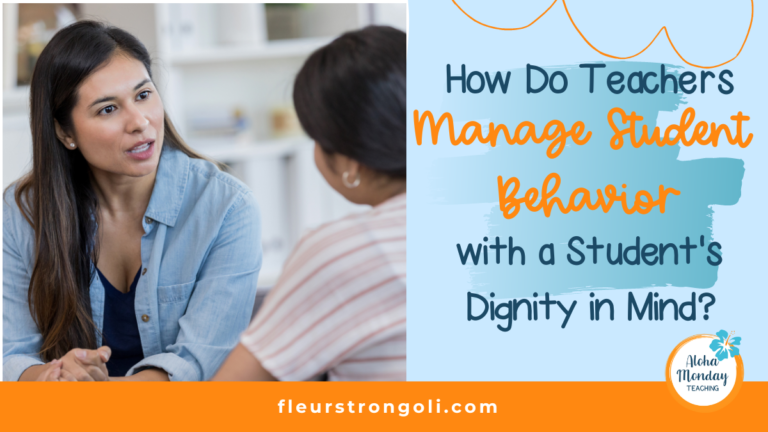


6 Comments